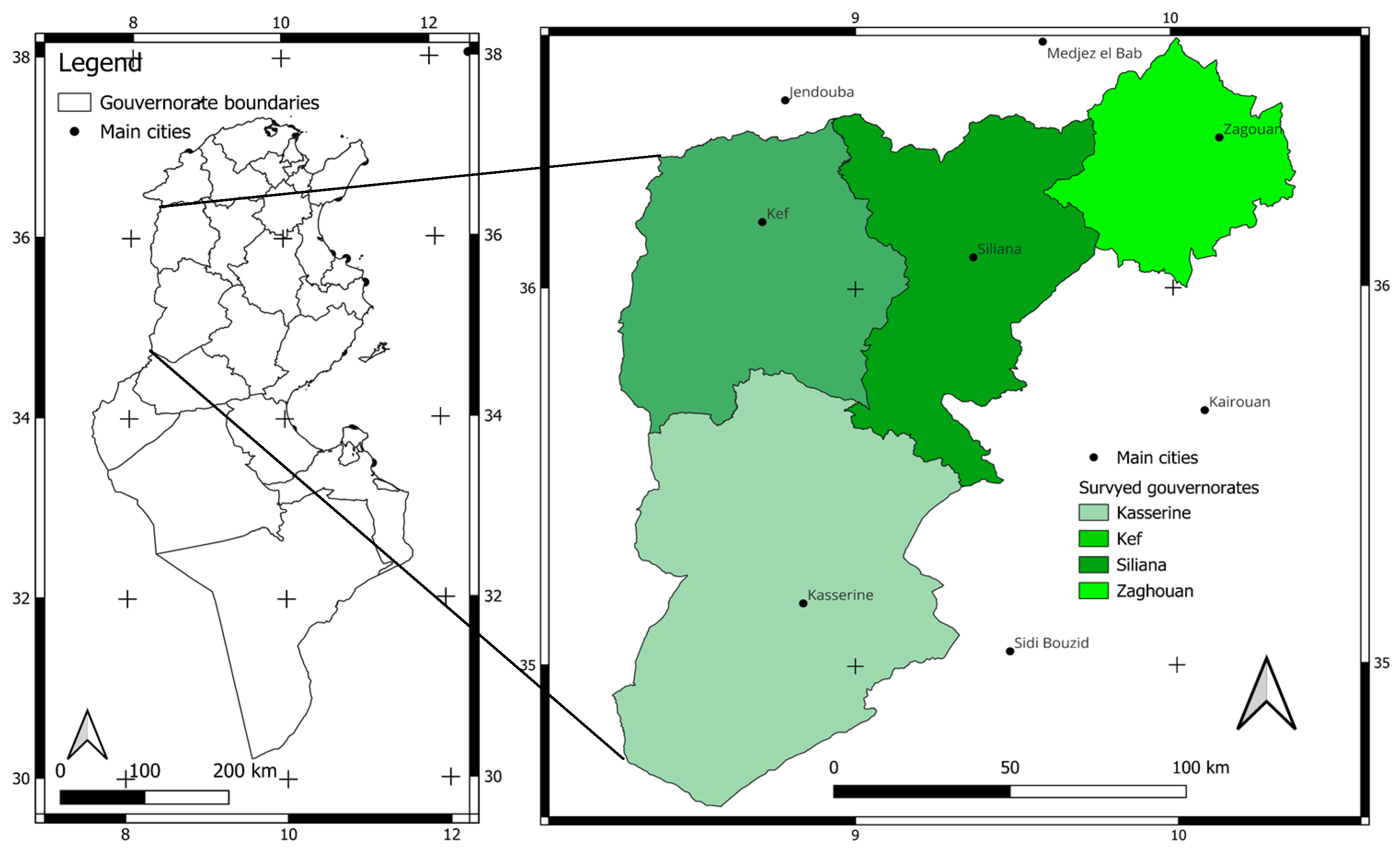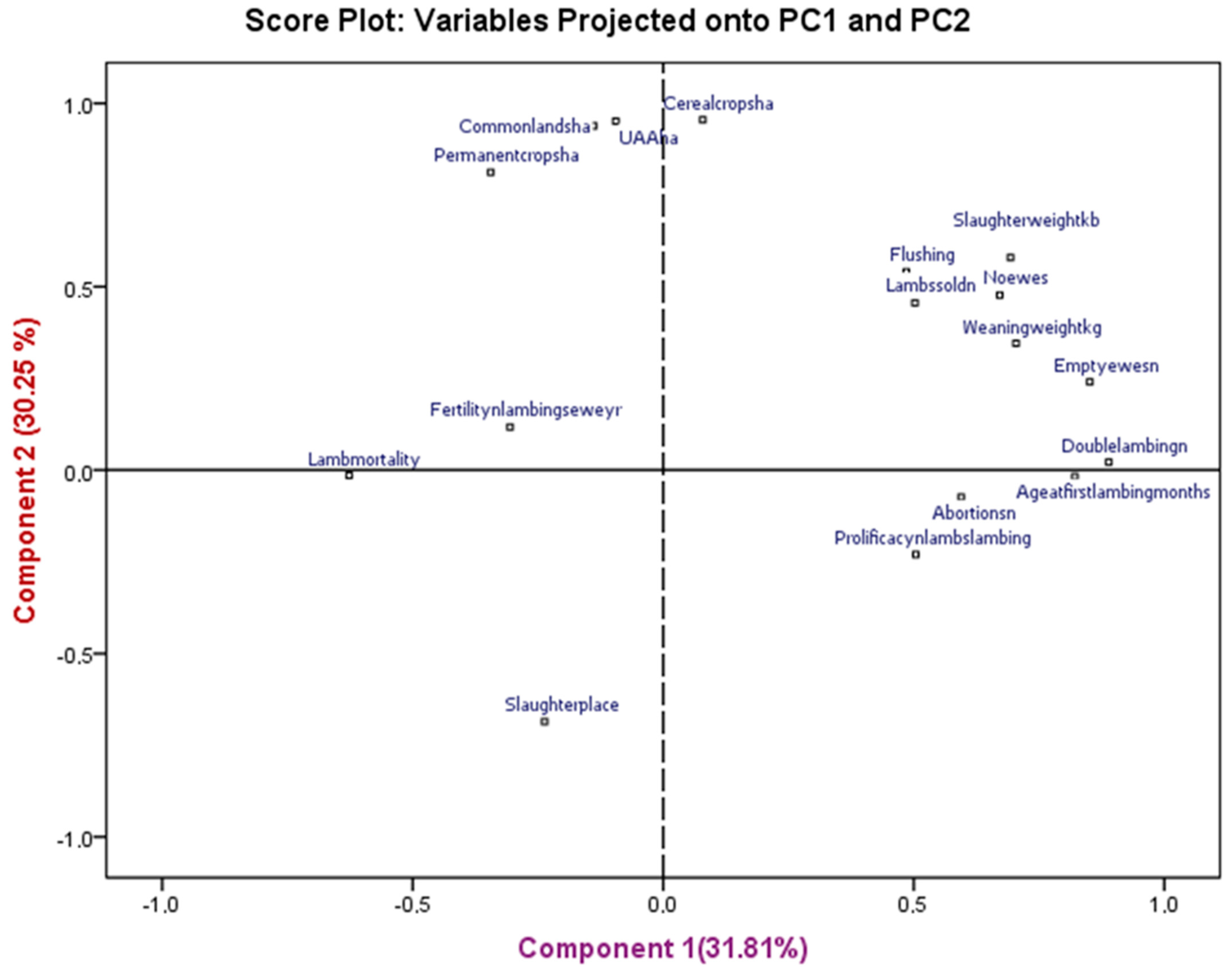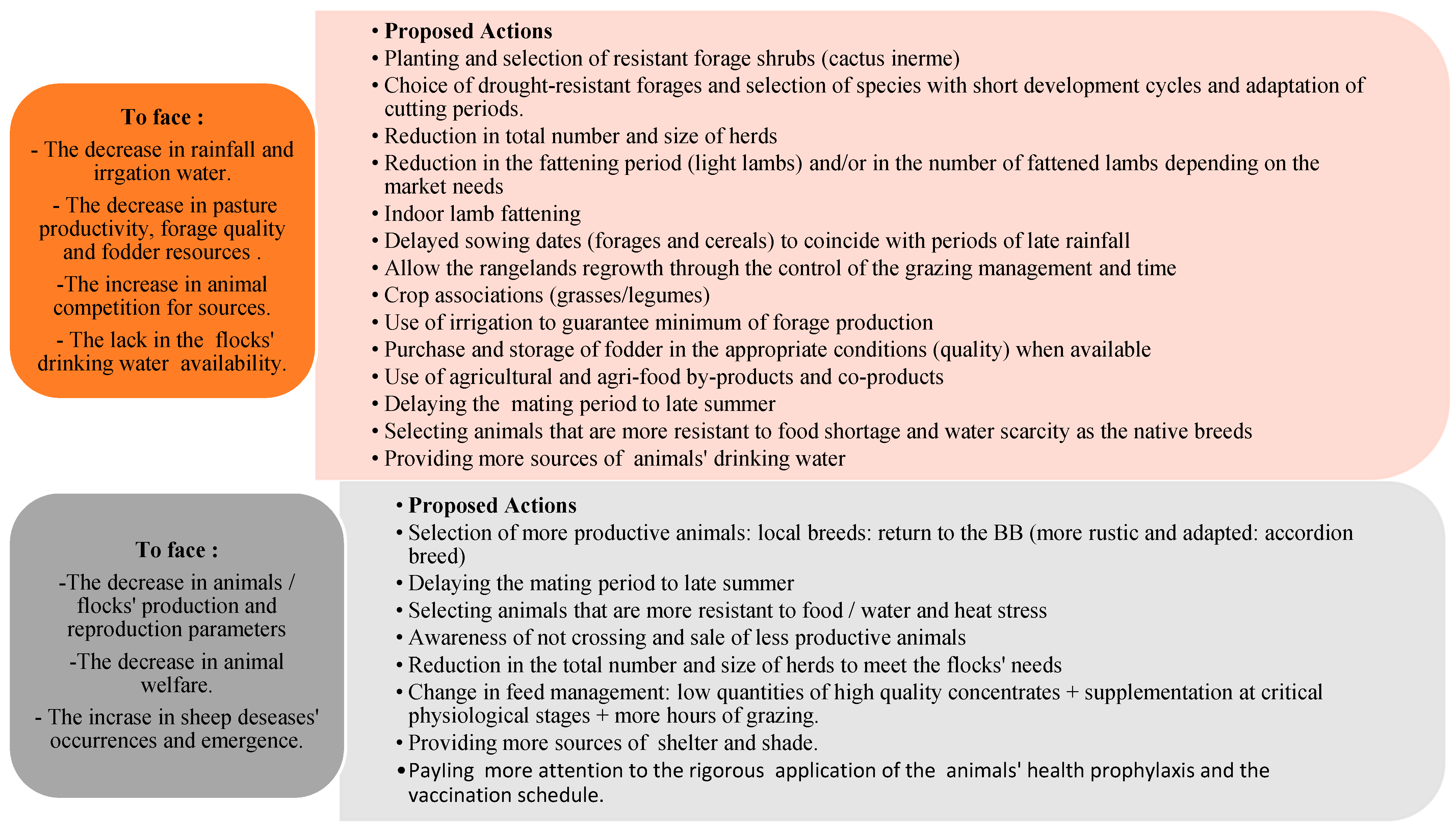Analysis of Management Practices and Breeders’ Perceptions of Climate Change’s Impact to Enhance the Resilience of Sheep Production Systems: A Case Study in the Tunisian Semi-Arid Zone
Abstract
Simple Summary
Abstract
1. Introduction
2. Material and Methods
2.1. Study Area
2.2. Data Collection
2.3. Multivariate Analysis
3. Results and Discussion
3.1. General Characterization of the Surveyed Farms
3.2. Typology of the Sheep Production Systems
3.2.1. Characterization of the Identified Sheep Production Systems
Sheep Farmers’ Socioeconomic Characterization, Land Structure, and Use
Herd Management and Animal Commercialization
Herd Reproductive Practices and Feeding Management
3.3. Sheep Farmers’ Perceptions of Climatic Severity in the Study Area
3.3.1. Historical and Future Climatic Conditions in the Semi-Arid Zone
3.3.2. Farmers’ Climate Perceptions: Occurrence, Manifestations, and Causes
Raised Climate Impacts on the Sheep Production Systems
- The decrease in rainfall and irrigating water;
- The decrease in pasture productivity, forage quality, and fodder resource availability;
- The variability in seasonal forage availability;
- The decrease in the availability and quality of the flocks’ drinking water;
- An increased effect of heat stress on the animals’ welfare and health;
- The decrease in individuals’ and flocks’ productive and reproductive performances; and welfare
- The increase in mortality rates because of diseases’ occurrence and emergence.
General Resilience Actions
- Case of the agro-pastoral irrigated sheep production system
- b.
- Case of the agro-pastoral rain-fed sheep production system
- c.
- Case of the agro-sylvo-pastoral sheep production system
- -
- Diversification of forage systems and crops as an effective lever for securing production at every level and by using several varieties, depending on earliness, in particular;
- -
- Use of straw, leaves, and other natural fiber to feed their flocks by creating a traditional multifunctional landscape, i.e., forestry trees combined with pastures, grazing sheep, and goats, as well as cereal or forage agriculture;
- -
- Use of autochthone animal breeds (Barbarine and QFO).
4. Conclusions and Recommendations
Author Contributions
Funding
Institutional Review Board Statement
Informed Consent Statement
Data Availability Statement
Acknowledgments
Conflicts of Interest
References
- Banos, G.; Li, B. Genomics of Sheep Resilience to Climate Change; PR640-05; AHDB: Coventry, UK, 2022; Volume 17, Available online: https://projectblue.blob.core.windows.net/media/Default/Research%20Papers/AHDB/2022/PR640-05%20Final%20report%20AHDB-BBSRC%20Farm%20Sustainability%20Fund%20(Banos).pdf (accessed on 11 February 2023).
- Feleke, F.B.; Berhe, M.; Gebru, G.; Hoag, D. Determinants of adaptation choices to climate change by sheep and goat farmers in Northern Ethiopia: The case of Southern and Central Tigray, Ethiopia. SpringerPlus 2016, 5, 1692. [Google Scholar] [CrossRef] [PubMed]
- Sejian, V.; Fonsêca, V. Climate Resilient Small Ruminant Production: Impact and Alleviation. Small Rumin. Res. Spec. Issue 2022, 10RPN231649. Available online: https://www.sciencedirect.com/journal/small-ruminant-research/special-issue/10RPN231649 (accessed on 5 April 2023).
- Joy, A.; Dunshea, F.R.; Leury, B.J.; Clarke, I.J.; DiGiacomo, K.; Chauhan, S.S. Resilience of Small Ruminants to Climate Change and Increased Environmental Temperature: A Review. Animals 2020, 10, 867. [Google Scholar] [CrossRef] [PubMed]
- Hammami, M.; Soltani, E.; Selmi, H. Sheep farming in semi-arid region: Its functions and its involvement in the formation of farm income (case of family farms of the delegation of Zaghouan—Tunisia). Livest. Res. Rural Dev. 2023, 23, 153. [Google Scholar]
- Mekki, I.; Malouche, D.; Smeti, S.; Hajji, H.; Mahouachi, M.; Elloumi, M.; Atti, N. Caractérisation des systèmes d’élevage ovins dans un milieu montagneux: Cas du Nord-Ouest Tunisien. Livest. Res. Rural Dev. 2019, 31, 108. [Google Scholar]
- Farhani, N.; Carreau, J.; Kassouk, Z.; Le Page, M.; Lili Chabaane, Z.; Boulet, G. Analysis of Multispectral Drought Indices in Central Tunisia. Remote Sens. 2022, 14, 1813. [Google Scholar] [CrossRef]
- Verner, D.; Treguer, D.O.; Redwood, J.; Christensen, J.; Mcdonnell, R.; Elbert, C.; Konishi, Y. Climate Variability, Drought, and Drought Management in Tunisia’s Agricultural Sector; (English); World Bank Group: Washington, DC, USA, 2018; Available online: http://documents.worldbank.org/curated/en/318211538415630621/Climate-Variability-Drought-and-Drought-Management-in-Tunisias-Agricultural-Sector (accessed on 15 April 2023).
- Mansour, M.; Hachicha, M.; Mougou, A. Trend Analysis of Potential Evapotranspiration Case of Chott-Meriem Region (The Sahel of Tunisia). Int. J. Agric. Innov. Res. 2017, 5, 703–708. Available online: https://ijair.org/administrator/components/com_jresearch/files/publications/IJAIR_2088_FINAL.pdf (accessed on 20 March 2023).
- Gaaloul, N.; Eslamian, S.; Katlane, R. Impacts of Climate Change and Water Resources Management in the Southern Mediterranean Countries. Water Prod. J. 2020, 1, 51–72. Available online: https://www.waterproductivity.net/article_119476_3eb63489fed313983575be7a18b57144.pdf (accessed on 25 June 2023).
- Ocak Yetisgin, S.; Önder, H.; Şen, U.; Piwczyński, D.; Kolenda, M.; Sitkowska, B.; Yucel, C. Farmers’ Risk Perception on Climate Change: Transhumance vs. Semi-Intensive Sheep Production Systems in Türkiye. Animals 2022, 12, 1992. Available online: https://www.mdpi.com/2076-2615/12/15/1992/pdf (accessed on 15 April 2023). [CrossRef] [PubMed]
- Rjili, H.; Muñoz-Ulecia, E.; Bernués, A.; Jaouad, M.; Martin-Collado, D. Evolution of pastoral livestock farming on arid rangelands in the last 15 years. Animal 2023, 17, 100748. [Google Scholar] [CrossRef] [PubMed]
- Bellahirich, S.; Mezghani, D.; Mami, A. 2021. Design and Implementation of an Intelligent ANFIS Controller on a Raspberry Pi Nano-Computer for Photovoltaic Pumping Intended for Drip Irrigation. Energies 2021, 14, 5217. [Google Scholar] [CrossRef]
- Chebbi, H.E.; Pellissier, J.P.; Khechimi, W.; Rolland, J.P. Rapport de Synthèse sur l’Agriculture en Tunisie; Research Report; CIHEAM-IAMM: Montpellier, France, 2019; Volume 99. [Google Scholar]
- AFD. Adapt’ Action PAN. Impacts des effets du Changement climatique sur la sécurité alimentaire. Onagri 2021, 151, 67–76. [Google Scholar]
- FAO. Les Dix Éléments de L’agroécologie—Guider la Transition agro Écologique vers des Systèmes Alimentaire et Agricoles Durables; FAO: Rome, Italy, 2018. [Google Scholar]
- Rekik, M.; Ben Hammouda, M. A steering frame for the genetic improvement of sheep and goats in Tunisia. Opt. Med. 2000, 43, 129–136. Available online: http://om.ciheam.org/om/pdf/a43/00600478.pdf (accessed on 4 February 2023).
- ONAGRI. Observatoire National de l’Agriculture. Le Tableau de Bord de L’observatoire National de L’agriculture. 2023. Available online: http://www.onagri.tn/uploads/dash-board/TB_2022_VF-09_2022.pdf (accessed on 14 August 2023).
- Jemaa, T.; Huguenin, J.; Moulin, C.; Najar, T. Les systèmes d’élevage de petits ruminants en Tunisie Centrale: Stratégies différenciées et adaptations aux transformations du territoire. Cah. D’agric. 2016, 25, 45005. Available online: https://www.cahiersagricultures.fr/articles/cagri/abs/2016/04/cagri160018/cagri160018.html (accessed on 6 August 2023). [CrossRef]
- Musafiri, C.M.; Macharia, J.M.; Ng’etich, O.K.; Kiboi, M.N.; Okeyo, J.; Shisanya, C.A.; Okwuosa, E.A.; Mugendi, D.N.; Ngetich, F.K. Farming systems’ typologies analysis to inform agricultural greenhouse gas emissions potential from smallholder rain-fed farms in Kenya. Sci. Afr. 2020, 8, e00458. [Google Scholar] [CrossRef]
- Jaadi, Z. A Step-by-Step Explanation of Principal Component Analysis (PCA). 2023. Available online: https://builtin.com/data-science/step-step-explanation-principal-component-analysis (accessed on 14 September 2023).
- Hair, F.; Black, C.; Babin, J.; Anderson, E. Multivariate Data Analysis, 7th ed.; Pearson Education Inc.: Upper Saddle River, NJ, USA, 2010; pp. 627–687. [Google Scholar]
- Madry, W.; Mena, Y.; Roszkowska-Madra, B.; Gozdowski, D.; Hryniewski, R.; Castel, J.M. An overview of farming system typology methodologies and its use in the study of pasture-based farming system: A review. Span. J. Agric. Res. 2013, 11, 316–326. [Google Scholar] [CrossRef]
- Field, A. Discovering Statistics Using IBM SPSS Statistics, 4th ed.; SAGE Publications: Thousand Oaks, CA, USA, 2013; Available online: http://repo.darmajaya.ac.id/5678/1/Discovering%20Statistics%20Using%20IBM%20SPSS%20Statistics%20%28%20PDFDrive%20%29.pdf (accessed on 12 November 2023).
- BPS. Jawa Timur Dalamangka; BPS-Statistics East Java: Surabaya, Indonesia, 2000. [Google Scholar]
- Mthi, S.; Skenjana, A.; Fayemi, P.O. Characteristics of small-scale sheep production systems in some communal areas of the Eastern Cape Province, South Africa. Int. J. Livest. Prod. 2017, 8, 199–206. [Google Scholar] [CrossRef][Green Version]
- Yilmaz, D.; Ben-Nasr, S.; Mantes, A.; Ben-Khalifa, N.; Daghari, I. Climate Change, Loss of Agricultural Output and the Macro-Economy: The Case of Tunisia. In AFD Research Papers; 2023; pp. 1–106. Available online: https://www.cairn-int.info/journal-afd-research-papers-2023-286-page-1 (accessed on 2 July 2023).
- Amamou, H.; Ben Sassi, M.; Aouadi, H.; Khemiri, H.; Mahouachi, M.; Beckers, Y.; Hammami, H. Climate change-related risks and adaptation strategies as perceived in dairy cattle farming systems in Tunisia. Clim. Risk Manag. 2018, 20, 38–49. [Google Scholar] [CrossRef]





| Variable Description | Abbreviation (Unit) |
|---|---|
| Utilized agricultural area | UAA (ha) |
| Forage crops | FC (ha) |
| Cereal crops | CC (ha) |
| Permanent crops | PC (ha) |
| Common lands | CL (ha) |
| Main breed | MB |
| Flushing | FL (yes/no) |
| Age at first lambing | AFL (months) |
| Productivity | PR (n lambs sold/ewe/year) |
| Replacement rate | RR (%) |
| Abortion rate | AB (%) |
| Empty ewes | EE (%) |
| Double lambing | DL (number/farm) |
| Lamb mortality | LM (%) |
| Age at weaning | AW (months) |
| Weaning weight | WW (kg) |
| Age at slaughter | AS (months) |
| Slaughter weight | SW (kg) |
| Slaughter place | SP (slaughterhouse/other places) |
| Carcass weight | CW (kg) |
| Lambs sold | LS (number of sold lambs/farm) |
| Selling criteria | SC (Live weight/lamb age) |
| Lambs for self-consumption | LFC (number of lambs for self-consumption/farm) |
| Continuity of the sheep-rearing activity | CN (yes/no) |
| Total Explained Variance | |||||||||
|---|---|---|---|---|---|---|---|---|---|
| Component | Own Initial Values | Extraction Sum of Squares of Selected Factors | Sum of Squares of Rotation Factors | ||||||
| Total | % of Variance | Cumulated % | Total | % Variance | Cumulated % | Total | % Variance | Cumulated % | |
| 1 | 6.50 | 38.23 | 38.23 | 6.50 | 38.23 | 38.23 | 5.40 | 31.81 | 31.81 |
| 2 | 4.05 | 23.83 | 62.06 | 4.05 | 23.83 | 62.06 | 5.14 | 30.25 | 62.06 |
| Variable/Production System | AGPR (55%) | AGPI (20%) | AGSP (25%) |
|---|---|---|---|
| Main breed | Queue Fine de l’Ouest (62%) | Queue Fine de l’Ouest (91%) | Barbarine (58%) |
| Utilized agricultural area (UAA): (ha) | 118 ± 45 | 22.6 ± 13 | 59.1 ± 12 |
| Permanent crops (ha) | 16.5 ± 7 | 8.1 ± 4 | 2.3 ± 1 |
| Common land (ha) | 73 ± 39 | 12 ± 7 | 166 ± 154 |
| Forage crops (ha) | 30.9 ± 22 | 1.8 ± 3 | 0.1 ± 2 |
| Cereal crops (ha) | 70 ± 12 | 12.7 ± 9 | 56.8 ± 53 |
| Irrigated crops (% UAA) | 0 | 48 | 0 |
| Age at first mating (months) | 15 ± 5 | 16 ± 3 | 16 ± 2 |
| Adult and lamb feed supplementation (%) | 42% | 67% | 4% |
| Productivity (n lambs sold/ewe/year) | 0.9 | 0.9 | 0.8 |
| Replacement rate (%) | 14 | 17 | 14 |
| Weight as selling criteria (%) | 44 | 80 | 82 |
| Lambs mortality (%) | 8 | 10 | 10 |
| On-farm fattening (%) | 87 | 83 | 88 |
| Fertility rate (%) | 90 | 87 | 85 |
| Prolificacy rate (%) | 1.19 | 1.23 | 1.10 |
| By 2050 | By 2100 | |
|---|---|---|
| Temperature | +1.5 °C to + 1.9 °C | +1.9 °C to + 3.9 °C |
| Precipitations | −6% to −9% | −9% to −18% |
| Climate extremes | Longer duration of heat waves + high frequency of droughts and floods | |
| Production System Component | Forage System | Feeding System | Herd and Reproductive Management | Livestock Housing |
|---|---|---|---|---|
| Climate impacts | Decrease in forage production | Lack of feed resources | Decreased animal/flock performances | Increased thermal stress |
| Deterioration of forage quality | Increased feeding costs | Increased abortion and diseases and mortality rates (lambs) | Decreased animal welfare | |
| Decrease in the surface and production of the grazed area (rangelands and meadows) | Increased pressure on grazing resources | Reduced fertility and prolificacy rates |
Disclaimer/Publisher’s Note: The statements, opinions and data contained in all publications are solely those of the individual author(s) and contributor(s) and not of MDPI and/or the editor(s). MDPI and/or the editor(s) disclaim responsibility for any injury to people or property resulting from any ideas, methods, instructions or products referred to in the content. |
© 2024 by the authors. Licensee MDPI, Basel, Switzerland. This article is an open access article distributed under the terms and conditions of the Creative Commons Attribution (CC BY) license (https://creativecommons.org/licenses/by/4.0/).
Share and Cite
Mohamed-Brahmi, A.; Ameur, M.; Mekki, I.; Tenza-Peral, A.; Nasraoui, M.; Yagoubi, Y.; Smeti, S.; Ben Saïd, S.; Atti, N.; Lobón, S.; et al. Analysis of Management Practices and Breeders’ Perceptions of Climate Change’s Impact to Enhance the Resilience of Sheep Production Systems: A Case Study in the Tunisian Semi-Arid Zone. Animals 2024, 14, 885. https://doi.org/10.3390/ani14060885
Mohamed-Brahmi A, Ameur M, Mekki I, Tenza-Peral A, Nasraoui M, Yagoubi Y, Smeti S, Ben Saïd S, Atti N, Lobón S, et al. Analysis of Management Practices and Breeders’ Perceptions of Climate Change’s Impact to Enhance the Resilience of Sheep Production Systems: A Case Study in the Tunisian Semi-Arid Zone. Animals. 2024; 14(6):885. https://doi.org/10.3390/ani14060885
Chicago/Turabian StyleMohamed-Brahmi, Aziza, Mehrez Ameur, Ilyes Mekki, Alicia Tenza-Peral, Masarra Nasraoui, Yathreb Yagoubi, Samir Smeti, Samia Ben Saïd, Naziha Atti, Sandra Lobón, and et al. 2024. "Analysis of Management Practices and Breeders’ Perceptions of Climate Change’s Impact to Enhance the Resilience of Sheep Production Systems: A Case Study in the Tunisian Semi-Arid Zone" Animals 14, no. 6: 885. https://doi.org/10.3390/ani14060885
APA StyleMohamed-Brahmi, A., Ameur, M., Mekki, I., Tenza-Peral, A., Nasraoui, M., Yagoubi, Y., Smeti, S., Ben Saïd, S., Atti, N., Lobón, S., & Mahouachi, M. (2024). Analysis of Management Practices and Breeders’ Perceptions of Climate Change’s Impact to Enhance the Resilience of Sheep Production Systems: A Case Study in the Tunisian Semi-Arid Zone. Animals, 14(6), 885. https://doi.org/10.3390/ani14060885





